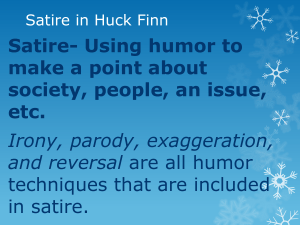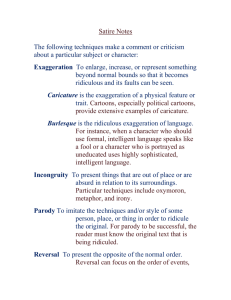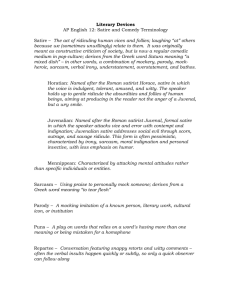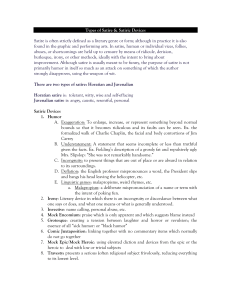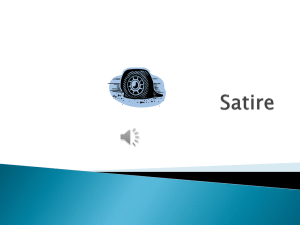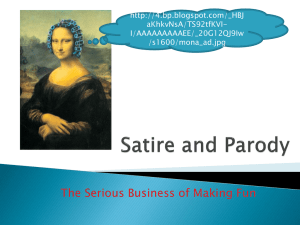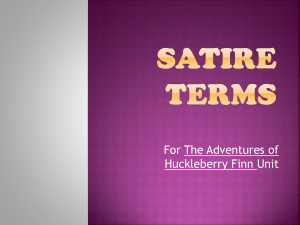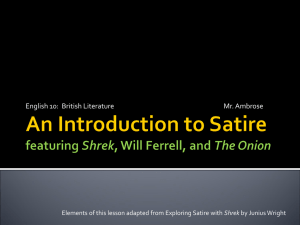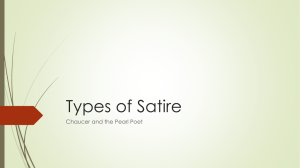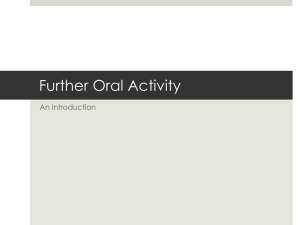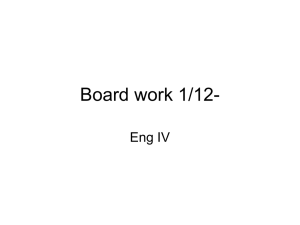File
advertisement
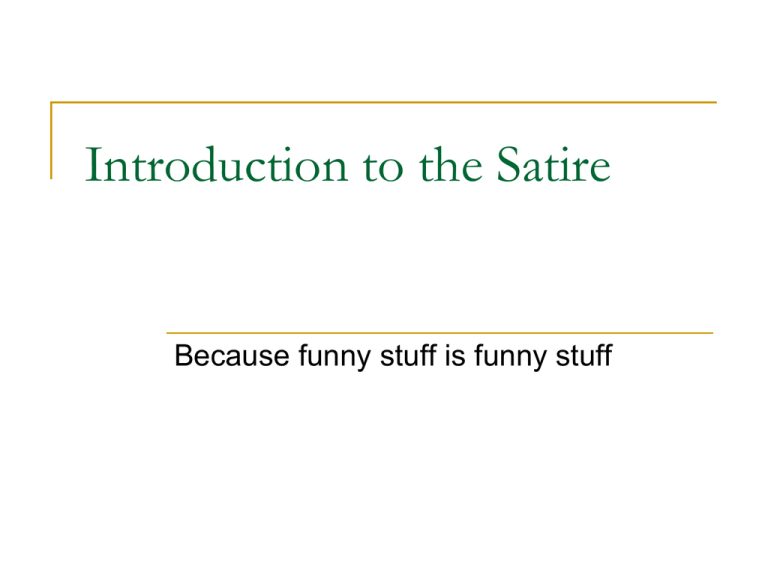
Introduction to the Satire Because funny stuff is funny stuff The Anatomy of Satire “‘Tis the intent and business of the stage, To copy out the follies of the age, To hold to every man a faithful glass, And show him of what species he’s an ass” -- John Vanburgh, The Provoked Wife (1697) Humor Devices Pre-Test 1. Humor Wit Comedy burlesque Satire Parody Verbal Irony 2. 3. 4. 5. 6. a work created to mock, comment on, or poke fun at an original work, its subject, author, style, or some other target, by means of humorous, satiric or ironic imitation. A form of intellectual humor the tendency of particular cognitive experiences to provoke laughter and provide amusement human or individual vices, follies, abuses, or shortcomings are censured by ridicule, derision, burlesque, irony, or other methods, ideally with the intent of improvement. any humorous discourse generally intended to amuse, especially in television, film, and standup. humorous theatrical entertainment involving parody and sometimes grotesque exaggeration Humor Devices Pre-Test 1. lampoon caricature slapstick travesty farce invective Situational irony poop 2. 3. 4. 5. 6. a portrait that exaggerates or distorts the essence of a person or thing to create an easily identifiable visual likeness. In literature, a description of a person using exaggeration of some characteristics and oversimplification of others a discrepancy between the expected result and actual results when enlivened by perverse appropriateness a comedy which aims to entertain the audience by means of unlikely, extravagant, and improbable situations, disguise and mistaken identity, verbal humor of varying degrees of sophistication, which may include sexual innuendo and word play, and a fast-paced plot whose speed usually increases, culminating in an ending which often involves an elaborate chase scene. Could be a form of parody or a humor magazine, or a famous movie corporation verse genre primarily of the Renaissance, descended from the tradition of in classical Greek and Roman poetry. Emotionally violent, verbal denunciation or attack of a person or group. type of comedy involving exaggerated physical violence and activities which exceed the boundaries of common sense. These exaggerated depictions are often found in children's cartoons, and light film comedies aimed at younger audiences What is Satire? Though he laughs, the satirist tells the truth Compels readers to look at a sight they missed or shunned - move them to protest Through laughter, aims to cure folly and punish evil COLLEGE FOOTBALL Types of Satire Horatian: gentle, sympathetic form of satire. Mildly mocks the subject. The audience is asked to laugh at themselves as much as the players. Types of Satire Juvenalian/juvenille: harsh and bitter satire Two Types of Satirists Optimist Likes people, but thinks they are rather blind and foolish Tells the truth with a smile Cures people of their ignorance Writes in order to heal Two Types of Satirists Pessimist Loves individuals, hates mankind Aim is to wound, to punish, to destroy Juvenalian satire The Onion (for tomorrow, I want you to go to the onion and find two articles that you liked. Print them, bring them to class, and bring a brief explanation of speaker, subject, audience). Forms of Satire Diatribe, Invective: Direct attack Stated without irony or sarcasm Do not have to figure out what the satirist is trying to say Dennis Miller, Chris Rock, George Carlin Forms of Satire Caricature, Exaggeration: Distortion for emphasis Usually focuses on powerful subjects Emphasize physical characteristics in order to make deeper criticism Parody Imitation which, through distortion and exaggeration, evokes amusement, derision, and sometimes scorn Borrows a pre-existing form The Daily Show, The Colbert Report Spaceballs Types of Parody Burlesque: Vulgar Treats subject with ridicule, vulgarity, distortion, and contempt “Dear companions hug and kiss, Toast old Glorious in your piss” -- Jonathan Swift on the Irish parliament Types of Parody Mock-heroic “like a laughing child wearing a full-scale suit of majestic armor” Grand diction, lofty style Takes a trivial or repellent theme and treats it with grandeur or feigned solemnity The Onion Headline: “Loser Spends Entire Day in Bed” Garrison Keillor: The last cigarette smokers in America were located in a box canyon south of Donner Pass in the High Sierra by two federal tobacco agents in a helicopter who spotted the little smoke puffs just before noon. One of them, the district chief, called in the ground team by air-to-ground radio. Six men in camouflage outfits, members of a crack anti-smoking joggers unit, moved quickly across the rugged terrain, surrounded the bunch in their hideout, subdued them with tear gas, and made them lie fact down on the gravel in the hot August sun. There were three females and two males, all in their midforties. They had been on the run since the adoption of the Twenty-eighth Amendment. What type of humor used? Give examples. To what extent do you agree with his comments? To what extent do you disagree. William Hogarth “How I want thee, humorous Hogarth! Thou, I hear, a pleasant rogue art; Were but you and I acquainted, Every monster should be painted; You should try your graving tools On this odious group of fools; Draw the beasts as I describe ‘em; Form their features, while I gibe ‘em, Draw them like, for I assure you, You will need no Car’catura -- Jonathan Swift

